Secret of Mana is the second installment in the action-RPG Mana series and arguably its most important. The first Mana videogame, Final Fantasy Adventure, is nominally a Final Fantasy spinoff but also sets the series conventions of real-time combat and a quest for the colossal Mana Tree that keeps the world’s elements in balance. Secret of Mana takes those conventions and builds onto them features that become iconic: ring-shaped menus, elemental magic channeled through spirits with unique personalities, a vibrant color palette, and an outstanding soundtrack. It’s rightly remembered as one of the most important and influential RPGs of the 16-bit era, giving audiences in the west a glimpse at a genre that would explode into the mainstream in the final years of the century. But is it a good videogame?
No, it is not.
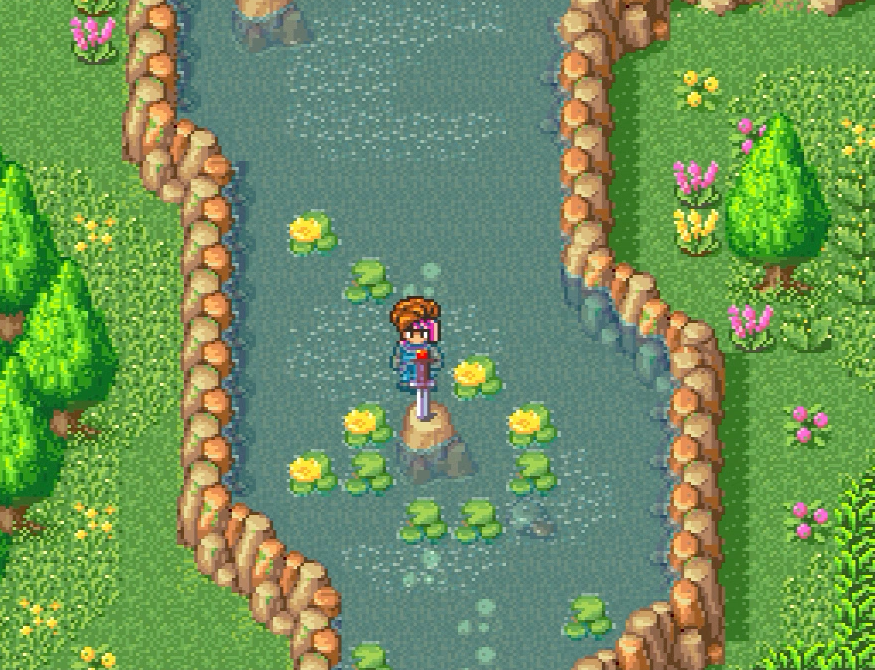
Secret of Mana is set in a world in decline. Mana, the planet’s elemental life force, has been weakening for centuries since a battle between god-sent beasts and an empire’s Mana-powered superweapon was ended by a warrior wielding the Mana Sword. One day, an orphan boy named Randi is exploring the waterfalls near his village when he is drawn by a mysterious voice to a sword driven into a stone. Pulling out the sword, Randi is shocked when the peaceful countryside suddenly teems with monsters. Exiled from his home for breaking the seal that kept the monsters at bay, Randi teams up with Primm, a noble’s rebellious daughter, and Popoi, an amnesiac sprite, to repower the sword, restore the balance of Mana, and seal the monsters away once more.
I control one of the three party members and can switch between them with the Select button. An AI controls the other two characters in combat and I may set their level of aggressiveness and favored range. This is handy since Primm and Popoi are more spellcasters than fighters and are easily overwhelmed in physical combat if I am not keeping an eye on them.
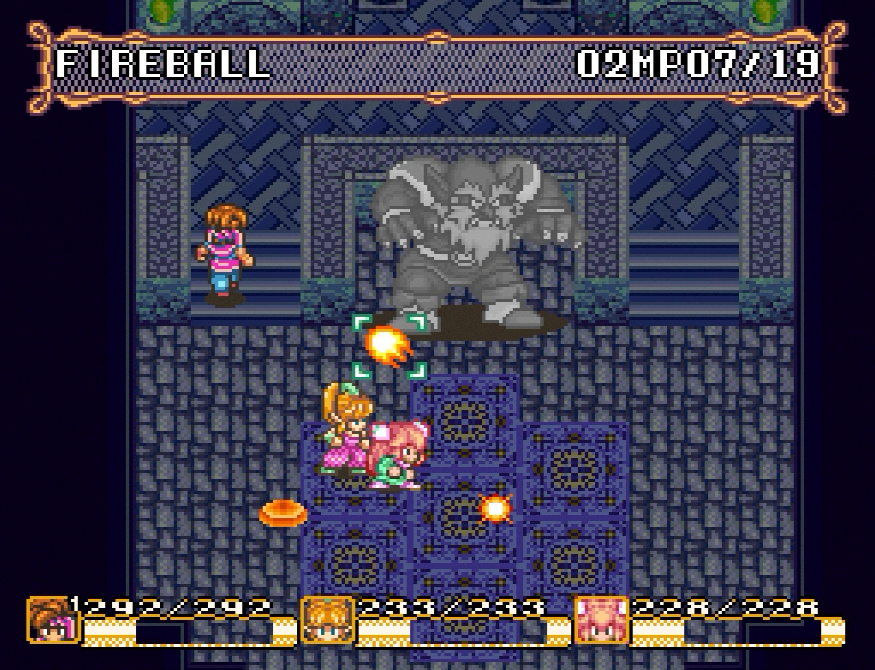
Depending on the platform and available peripherals up to two other players can join me on Randi’s quest. It’s not an interesting experience. The action often halts when a player needs to cast a spell or use an item as only one player can navigate these menus at a time. The player who gets stuck playing as Randi has the worst time as he never learns any magic at all. They are forced to use Secret of Mana’s frustrating and dull physical combat systems.
Secret of Mana has eight weapon types which are shared between the three player characters. Each has different ranges and damage capabilities. Many feel useless. The Glove’s weak power and minimal range makes it feel masochistic to fight with. The Bow and Javelin can attack from a distance but can only hit one enemy; the Boomerang and the Whip also attack from range and damage every enemy in their path. The damage difference between the four is negligible. There’s literally no reason to ever use the Bow or Javelin. Some weapons have utility applications needed to progress—the Axe can smash certain barriers, the Whip can pull the party across gaps—but most weapons feel included to make the videogame feel bigger than it is. Navigating the party’s armory feels like being overwhelmed with choices, most of them bad.
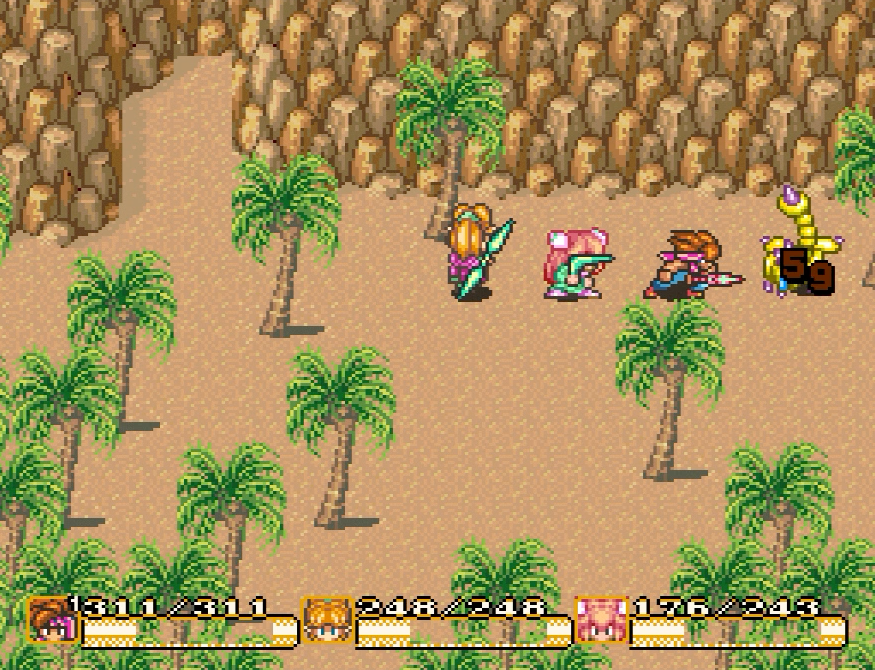
Each character’s combat performance is restrained by a stamina meter. With every attack, their stamina meter empties then refills about a second later. If I try to attack before the meter refills then the attack will be so weak as to be useless. Instead I must wait until the meter is full, run into range to attack once, then retreat to avoid enemy attacks until the meter fills again. The result is a more methodical combat system than the button mashing that can typify other action-RPGs. It’s not necessarily a bad system but it also feels like an attempt to fix something that was never broken. It stands out because of how much it slows down the pace in a way other action-RPGs find unnecessary.
One place I do feel frustration with the stamina meter is how it clashes with Secret of Mana’s poor damage feedback when I strike enemies. Weapons can be upgraded with orbs that drop from bosses or found in hidden chests. In addition to raw damage improvements, these upgrades also change a hidden effect added to each weapon tier. Losing these hidden effects means that an “upgrade” is often a downgrade when a weapon that was previously effective against an enemy suddenly becomes ineffective.
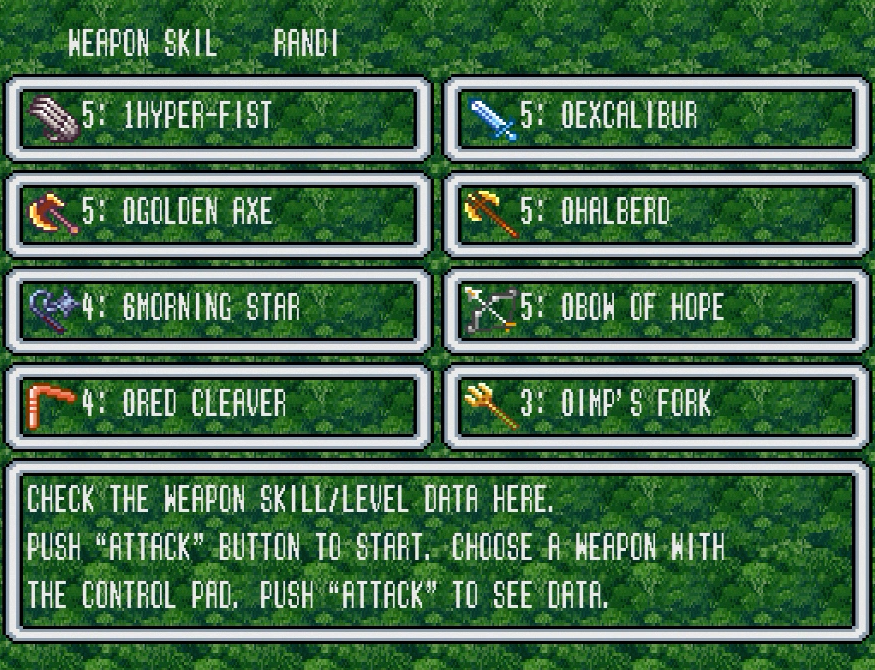
Often I will attack an enemy, no damage will register, and I will not know why. Are they resistant to the weapon? Are they not taking damage because another status effect is interrupting the damage? Was my attack too close to another party member’s attack, also interrupting the damage? Is the hit not registering because of where the enemy is standing in the environment? Am I simply not understanding where their hitbox is at? The answer could be any or none of these possibilities. A lack of feedback makes it frustrating to determine exactly why attacks don’t always register and the low damage output of weapons in general makes them an unappealing choice for combat, especially against bosses. And remember: Weapons are Randi’s only combat choice!
The other half of Secret of Mana’s combat systems is magic. When the party encounters the spirits who represent the elements of Mana, Primm and Popoi are taught spells related to that spirit’s element. Primm learns defensive magic that targets the party while Popoi learns offensive magic that targets enemies. The one and only spell I ever use with Primm is Cure Water which recovers the party’s health, but it’s such a useful ability that the relative uselessness of every other spell she learns is readily ignored. Popoi, on the other hand, is nothing less than the most powerful wizard in any RPG. The problem is it takes them a long time to get there.
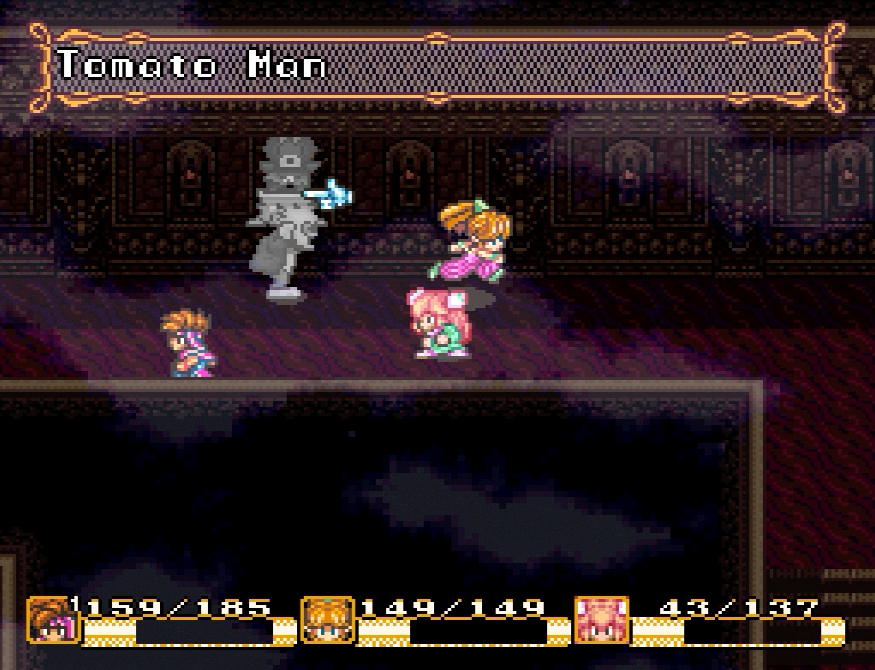
Most of Popoi’s spells only cost two or three MP to cast. The trouble is that for most of Secret of Mana’s playtime Popoi has very little MP to cast them. A single damaging spell killing most enemies in one hit is all well and good, but when there are several dozen enemies between the party and their destination and I blow through all Popoi’s MP killing five or ten of them, it can make returning to standard weapon attacks feel even more grating than before. I especially feel this in areas with enemies that can only be killed by Popoi’s magic. When I want to save Popoi’s all-powerful magic attacks for bosses, each MP I have to waste getting a standard enemy out of the way is more and more frustrating.
In one of Secret of Mana’s lowest points, there’s an early dungeon that features Tomato Men, flying enemies who summon an endless stream of zombies until they are killed. They are immune to all physical attacks, so Popoi’s magic is the only way to kill them. The boss of this area has a complication where it must be killed within a certain time limit or it’s an instant game over; Popoi’s magic is required to get past it. Naturally, the dungeon has so many Tomato Men that even making a straight shot to the dungeon boss will still use up all of Popoi’s MP. The best strategy is to run straight for the boss, ignoring every enemy along the way. When the only way to finish a videogame is to run past the videogame, your videogame has problems.
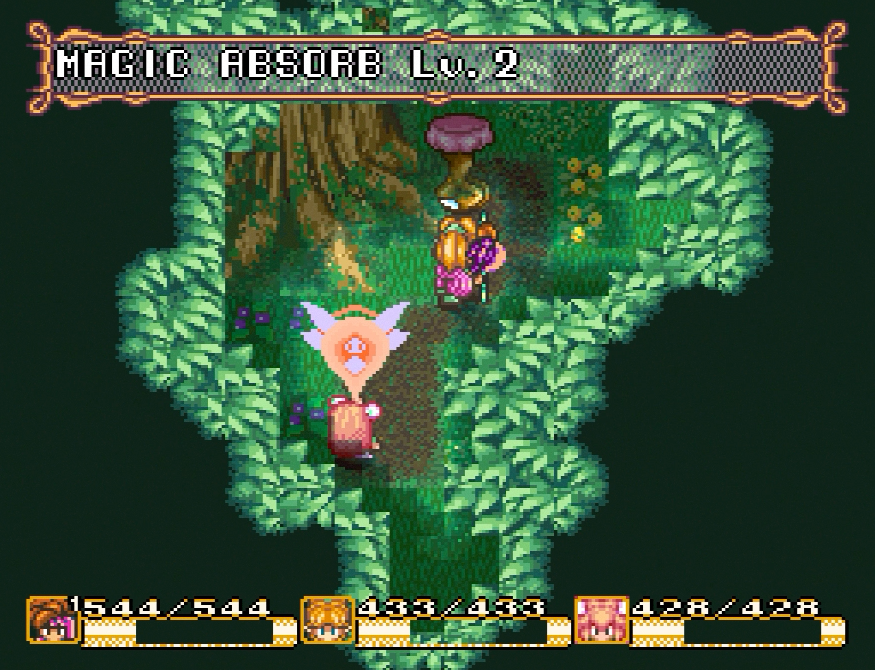
The obvious solution is to carry Faerie Walnuts, Secret of Mana’s MP-restoring item. These items are prohibitively expensive early on and item quantities are capped at four for no apparent reason. Even if I’m willing to spend too much money on Faerie Walnuts to keep Popoi’s magic powers charged, it only extends their usefulness up to four times. It’s a bad deal that’s tough to swallow.
The situation changes near Secret of Mana’s end when Faerie Walnuts become affordable, Popoi’s MP pool expands exponentially, and most significantly, they learn Absorb Magic. This spell allows Popoi to transfer MP from enemies to their own pool. It is surprisingly effective, costs a mere 1 MP to cast, and makes Popoi’s MP pool functionally bottomless. It’s incredible watching the diminutive sprite child, who spends the first three-quarters as the party’s weak link, basically solo the rest of the quest. Primm is there to heal Popoi. Randi is there to watch uselessly.
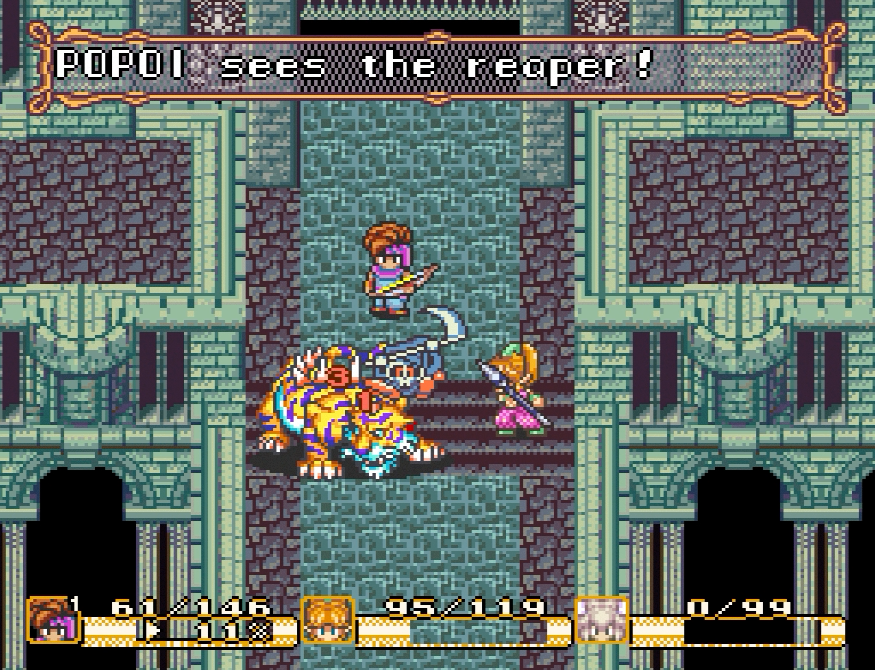
If I have made Secret of Mana’s combat systems sound miserable then I am glad. “Miserable” is a good word to describe them. There’s some devious delight to be found in decimating every enemy once Popoi’s attack magic becomes self-sustaining in the endgame. Until that happens fighting is at times frustrating, at times confounding, and at all times a tedious bore.
Secret of Mana was intended to be Square’s flagship title for Nintendo’s SNES CD-ROM addon. The CD-ROM format would have allowed for more text to be used to tell a story than in other console RPGs of the time. It seems quaint today when even small videogames have file sizes that tower over a SNES videogame, but in the early 90s it was very possible to use up all a cartridge’s limited storage on text, leaving little room for the graphics, sounds, and programming that make a videogame work as a storytelling medium. When the SNES CD-ROM addon fell through, Square was still on the hook to make Secret of Mana but now had to do it with a fraction of the storage space they expected. Cuts from both the script and later plot areas were mandated and they are incredibly apparent.
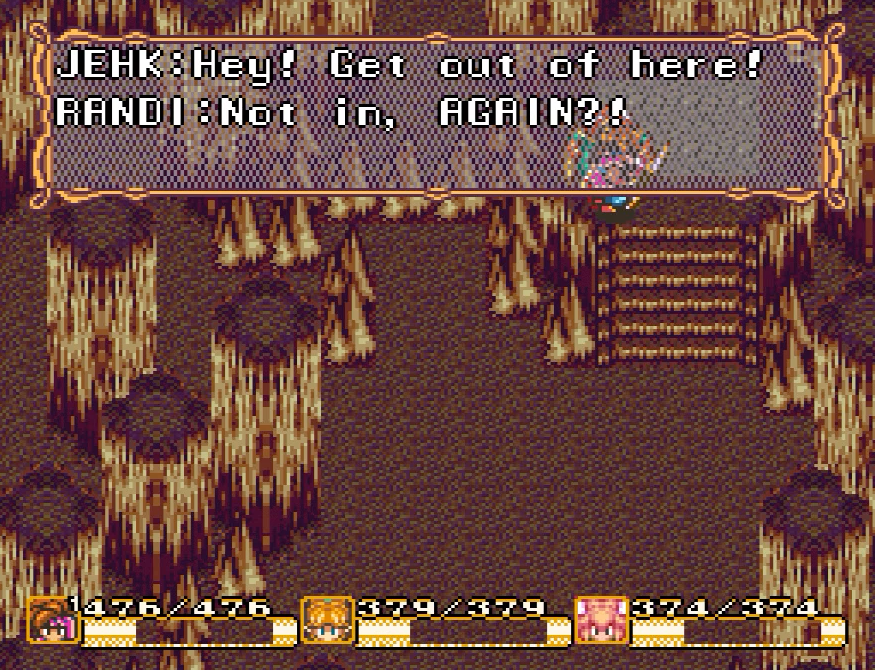
The main characters begin the quest talkative and involved in events but their interactions lessen as time goes on. There are several large castles filled with empty rooms, existing as hollow labyrinths that hint at the grander role they once served in the plot. The last few elemental spirits are visited in abbreviated dungeons, the mazes and enemies they once hosted replaced with a repeated climb up a mountain to talk to an NPC who directs me to the next plot point.
Once I am aware of Secret of Mana’s production history it is impossible not to see the holes left by cut content. But it doesn’t feel unfinished. It’s a compromise of a different vision now impossible to achieve, a half-finished canvas patched and mended to fit a differently shaped frame than what the artist intended.

Where Secret of Mana came out for the better from the SNES CD-ROM addon’s cancelation is in its music and sound design. The ambition is apparent from the start. When Square’s logo first appears on bootup it is accompanied by the Mana Beast’s ethereal wail. Next comes the title screen where a haunting piano picks out its keys before crescendoing into a full orchestra as birds fly across the Mana Tree. Tracks like “Into The Thick Of It,” with its memorable flute winding over chords picked out on an acoustic guitar, make fighting through the monster-infested wilderness between towns feel epic, while the cheerful piano underscoring a trilling electronic melody in “The Color of the Summer Sky” suits bustling, friendly villages. At times the music can even become too grand, some of its more intricate layers overridden by sound effects as the poor SNES hardware (or the software emulating it) isn’t capable of playing that many sounds at the same time.
Secret of Mana simply has one of the best soundtracks to ever grace the Super Nintendo. Whatever else I might dislike about it, I will feel some warmth towards it for its music alone.
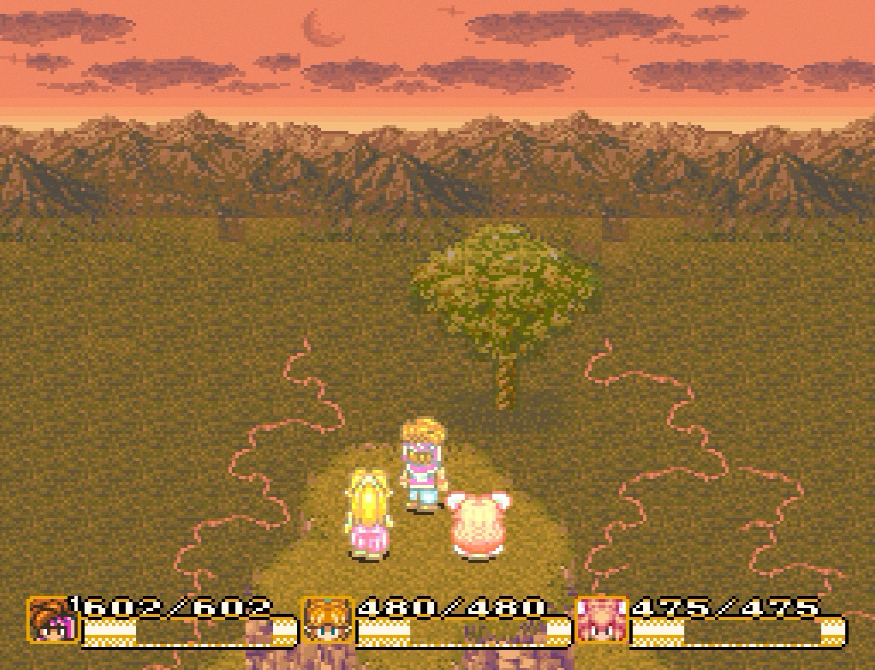
Twenty years ago I would have ranked Secret of Mana among my favorite videogames. Along with Super Mario RPG, I credit it with making me love RPGs. That love is gone, a preteen crush I now look back on with exasperation. I was bamboozled by its beautiful sprite graphics and incredible soundtrack, both of which hold up to scrutiny now almost thirty years later. Little else about the experience feels rewarding. I don’t believe in videogames “aging badly;” if a videogame feels bad to play now, it always felt bad only I didn’t have the knowledge and experience to recognize it. So it goes with Secret of Mana. I will always be grateful to it for serving as my gateway into RPGs, but I don’t recommend it to anyone else. It is a grind and a frustration and a bore.